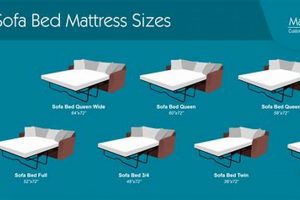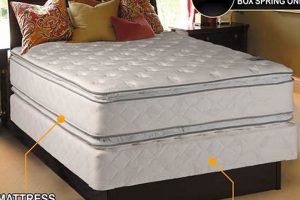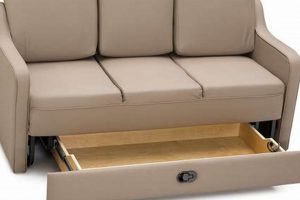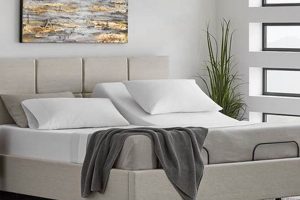The subject at hand pertains to a type of bedding designed for concealment within another piece of furniture, typically a sofa or cabinet. This allows for a dual-purpose furnishing; serving as everyday seating or storage, it readily converts into a sleeping surface as needed. An example would be a sofa that unfolds to reveal a full-sized sleeping surface, providing a comfortable bed for guests.
The importance of such convertible furniture lies in its space-saving functionality. This is particularly beneficial in smaller living spaces such as apartments or studio homes, where maximizing available area is essential. Historically, these space-saving designs have evolved to accommodate increased demands for both comfort and aesthetic appeal, becoming more sophisticated in their mechanism and construction. Benefits include increased versatility in room arrangement and the ability to host overnight guests without dedicating an entire room to a bed.
The following discussion will elaborate on the various types, mechanisms, and considerations associated with such adaptable bedding solutions, as well as factors influencing their selection and maintenance.
Optimizing Use of Convertible Bedding
The following are recommendations to ensure the longevity and comfort of adaptable bedding arrangements.
Tip 1: Measure Space Accurately. Prior to purchase, measure the intended space, both in its standard configuration and when fully extended. This prevents obstructions and ensures ease of use.
Tip 2: Prioritize Support and Comfort. Investigate the mattress component. High-density foam or innerspring designs provide greater support and comfort compared to thinner, less substantial options.
Tip 3: Inspect the Deployment Mechanism. Thoroughly test the opening and closing mechanism. Look for smooth operation and robust construction to prevent future malfunctions.
Tip 4: Consider Fabric Durability. The upholstery should withstand frequent use and potential spills. Opt for stain-resistant and durable materials that are easy to clean.
Tip 5: Utilize Protective Covers. Employ mattress protectors to shield the sleep surface from stains, allergens, and wear and tear. This extends the life of the bedding.
Tip 6: Follow Manufacturer Guidelines. Adhere to the manufacturer’s recommendations for cleaning and maintenance. Improper care can damage the mechanism or fabric.
Tip 7: Secure Surrounding Area. Clear the immediate area before deploying the sleep surface. Removing obstacles prevents damage and ensures safety during operation.
Applying these suggestions enhances the functionality, extends the lifespan, and maximizes comfort of concealed bedding solutions, ensuring a practical and convenient space-saving option.
The subsequent section will summarize the key considerations for selecting and maintaining these adaptive furniture pieces, solidifying their value within diverse living environments.
1. Space Optimization
The core function of concealing a bed within another piece of furniture directly addresses the challenge of space optimization, particularly within compact living environments. The cause-and-effect relationship is evident: limited square footage necessitates multi-functional furniture; a bed hidden within a sofa or cabinet effectively maximizes available space. Space optimization is not merely a beneficial feature but a fundamental component of this design, allowing for the efficient utilization of a single room for multiple purposes, serving as both a living and sleeping area.
A real-life example is a studio apartment where a standard bed would consume a significant portion of the floor plan. Employing a hidden bed solution allows the occupant to convert the living space into a bedroom only when needed, freeing up valuable area for daily activities. The practical significance of this understanding lies in its ability to improve the quality of life for individuals in smaller homes. It enables them to enjoy the comforts of both a living room and a bedroom without compromising on space. Another example is urban living spaces where optimizing space is extremely important. A hide a bed mattress enables the possibility of having a guest bedroom in small urban properties.
In summary, the success of concealed bedding solutions hinges on their inherent contribution to space optimization. The design minimizes spatial burden, offering adaptable functionality in response to limited areas. While maintenance and comfort are important, the spatial efficiency offered remains the key determinant of its utility, especially in increasingly dense urban environments.
2. Mechanism Reliability
The operational integrity of a concealed bedding apparatus is fundamentally contingent upon the reliability of its deployment mechanism. This connection signifies a critical point: if the mechanism fails, the inherent utility of the entire unit is severely compromised, rendering it non-functional as intended. A robust mechanism ensures smooth, consistent, and safe transition between its primary and secondary states. A cause-and-effect relationship exists: consistent and proper deployment leads to prolonged utility; conversely, a faulty mechanism results in operational failure and potential safety hazards. Mechanism reliability is thus a critical determinant of product lifespan and user satisfaction.
For example, consider a scenario where a guest room needs to be prepared quickly. A reliably engineered folding mechanism allows for rapid conversion, facilitating a swift and efficient setup. In contrast, a poorly designed mechanism might jam, require excessive force, or even break, leading to user frustration and potential injury. This highlights the necessity for rigorous testing and high-quality componentry in the construction of these mechanisms. Another practical aspect lies in preventing accidents: a secure locking mechanism prevents unintended collapses, ensuring user safety while in use. Moreover, smooth functionality significantly impacts the lifespan of connected components. A herky jerky movement, or a poorly designed hinge causes more tear and wear on the fabric, the internal mattress as well as the joints which causes stress.
In conclusion, mechanism reliability constitutes a keystone element in the overall value and functionality of concealed bedding solutions. Its impact spans from ease of use and safety to longevity and cost-effectiveness. Consequently, consumers should prioritize products incorporating well-engineered and durable mechanisms, as this factor directly correlates to the long-term practicality and utility of the item within the living space. Prioritize inspecting the warranty on the hardware rather than just overall warranty to get a better understanding of the product life cycle and robustness.
3. Mattress Quality
Mattress quality represents a pivotal determinant in the overall utility and comfort of concealed bedding solutions. It transcends mere cushioning, influencing spinal alignment, sleep quality, and the longevity of the furniture piece itself. The composition, construction, and density of the mattress directly correlate with its suitability for both occasional and regular use within these integrated systems.
- Foam Density and Composition
The density of the foam, whether memory foam or high-density polyurethane, dictates the level of support provided. Higher density foams offer superior contouring and pressure relief, crucial for spinal alignment and preventing pressure points. Low-density foams, while cost-effective, tend to sag prematurely and provide inadequate support, diminishing sleep quality. For example, a concealed bed intended for daily use would necessitate a high-density foam construction to withstand prolonged use and maintain its structural integrity.
- Innerspring Construction
Innerspring mattresses offer a traditional approach to support, utilizing coils to distribute weight. The gauge and configuration of these coils influence the firmness and responsiveness of the mattress. A higher coil count and strategically zoned support can enhance comfort and minimize motion transfer, particularly important for couples sharing the bed. A bed used to serve guests can benefit from a combination of pocketed coil and foam which offer balance. This is especially useful because it serves multiple types of people with different requirements.
- Thickness and Profile
The thickness of the mattress must be compatible with the folding mechanism of the concealed bed. An excessively thick mattress may impede proper closure or exert undue stress on the mechanism. Conversely, an overly thin mattress may compromise comfort and support. The profile must strike a balance between sufficient cushioning and seamless integration within the furniture frame. Mattress thickness can be a limiting factor. It can impact the longevity of the folding mechanism. In addition to mattress thickness, other important physical property is the weight, which impacts hardware and mechanism.
- Breathability and Temperature Regulation
Mattress breathability is crucial for temperature regulation and preventing the accumulation of moisture. Materials such as open-cell foam and breathable fabrics promote airflow, dissipating heat and reducing the risk of overheating during sleep. Poor breathability can lead to discomfort and even contribute to the growth of mold or mildew within the concealed structure. As an example, people living in humid climates, mattress breathability should be prioritised.
The selection of a mattress with appropriate attributes directly impacts the overall value and satisfaction derived from a concealed bedding solution. High-quality mattresses not only enhance sleep quality but also contribute to the longevity and usability of the furniture piece, solidifying its role as a practical and comfortable space-saving alternative. In conclusion, while mechanism and size are important, selecting the correct mattress is critical.
4. Fabric Durability
Fabric durability represents a critical aspect in the overall performance and longevity of concealed bedding. The upholstery material encasing such a unit is subject to significant wear and tear due to its dual function as both seating and bedding. Inadequately durable fabrics will exhibit premature degradation, diminishing the aesthetic appeal and functionality of the piece. A direct correlation exists: robust fabric resists damage from repeated use, extending the lifespan of the hidden bed; conversely, weak fabric deteriorates quickly, requiring costly repairs or replacement. Therefore, fabric durability serves as a crucial component of the concealed bed’s overall value proposition. The overall utility of a product is reduced if fabric isn’t durable.
For example, consider a concealed bed located in a frequently used living room. The fabric must withstand daily seating, potential spills, and friction from the folding mechanism. A fabric like tightly woven microfiber or treated canvas will resist stains, tears, and fading, maintaining its appearance over time. In contrast, a delicate fabric such as silk or thin linen would quickly show signs of wear, requiring constant cleaning and potentially leading to irreversible damage. From a functional view, strong fabric also adds more structural strength. For example, it helps in the support of the mattress and structural components within the frame.
In summary, the selection of a durable fabric is paramount for ensuring the long-term utility and aesthetic appeal of a hidden bed solution. The ability of the fabric to withstand the rigors of both seating and sleeping usage directly impacts the product’s lifespan and user satisfaction. While factors such as comfort and design are important, prioritizing fabric durability mitigates the risk of premature wear and tear, safeguarding the investment and guaranteeing sustained functionality.Prioritizing fabric material is key as the structure must withstand the test of time.
5. Ease of Use
The concept of ease of use is paramount in the context of concealed bedding solutions. The practical value of a hidden bed diminishes significantly if its deployment and retraction are cumbersome or complex. The following outlines key facets that contribute to the user-friendliness of such systems.
- Deployment Mechanism Accessibility
The accessibility and intuitiveness of the deployment mechanism are critical for ease of use. A poorly designed mechanism, requiring excessive force or intricate steps, can deter frequent use and diminish user satisfaction. Mechanisms that are easily accessible and operate smoothly, such as those with assisted lift features, contribute significantly to a positive user experience. Real-world examples include spring-assisted mechanisms that require minimal physical exertion to operate, or clear, concise instructions permanently affixed to the unit. Accessibility impacts older populations as well. Complex, difficult mechanisms prevent use.
- Weight and Maneuverability
The weight and maneuverability of the mattress and folding components directly impact the ease with which the bed can be deployed and retracted. Heavy mattresses or cumbersome folding mechanisms necessitate greater physical exertion, potentially limiting the user base to those with sufficient strength and mobility. Lightweight materials and intelligently designed folding systems enhance maneuverability, making the bed accessible to a wider range of users. For instance, the use of lightweight aluminum frames and memory foam mattresses contribute to reduced weight and increased ease of handling. Furthermore, the implementation of locking wheels allows for easy maneuvering from location to location.
- Clarity of Instructions and Labeling
Clear, concise instructions and intuitive labeling are essential for guiding users through the deployment and retraction process. Ambiguous or poorly illustrated instructions can lead to confusion, frustration, and potential damage
to the unit. Clearly labeled components and step-by-step instructions, preferably with visual aids, ensure that users can operate the bed safely and efficiently. An example of good design is a system with color-coded levers and corresponding diagrams illustrating the correct sequence of operation. Color coordination aids in streamlining the process. If a user makes a mistake in following an instruction, warnings must be presented to prevent failures. - Minimal Clearance Requirements
Ease of use is also influenced by the clearance requirements for deployment and retraction. Systems that require a significant amount of open space around the unit can be impractical in smaller rooms or confined spaces. Designs that minimize clearance requirements, such as vertical folding beds or those with compact folding mechanisms, offer greater flexibility in placement and enhance overall usability. An example is a bed that folds directly against a wall, requiring minimal floor space for operation. This also makes efficient use of space, enabling furniture pieces to stay in place during conversion. This leads to improved ease of use.
These facets collectively contribute to the overall ease of use of a hidden bed, directly impacting its practicality and appeal. Systems that prioritize these elements offer a more seamless and enjoyable user experience, maximizing the value and utility of the space-saving furniture piece. The utility of the product lies in easy configuration, deployment, and handling.
6. Maintenance Requirements
The operational longevity and hygiene of a hidden bed mattress system are directly influenced by adherence to stipulated maintenance requirements. Neglecting these requirements precipitates functional degradation and poses potential health concerns. The cause-and-effect relationship is evident: consistent maintenance procedures prolong lifespan and uphold sanitary standards; conversely, disregard for maintenance results in premature wear, potential mechanical failures, and the accumulation of allergens and pathogens. Maintenance is not merely an ancillary consideration, but an integral component affecting the performance and safety of these space-saving furniture solutions. Real-life examples include the regular vacuuming of the mattress to prevent dust mite infestation and the lubrication of folding mechanisms to ensure smooth operation. The practical significance of understanding this lies in the ability to preserve the investment in the furniture and safeguard the health of users.
Further analysis reveals that specific maintenance routines vary depending on the type of hidden bed mattress system. Sofa beds with intricate folding mechanisms require periodic inspection and cleaning to prevent debris accumulation that could impede functionality. Wall beds, often stored vertically, may necessitate less frequent but equally thorough cleaning to address dust settling within the enclosure. Practical applications include implementing a checklist of maintenance tasks to be performed at regular intervals, tailored to the specific model. This may encompass spot-cleaning upholstery to remove stains, inspecting and tightening hardware to prevent loosening, and airing out the mattress to eliminate odors and moisture buildup. The mattress should be flipped on a scheduled cadence to distribute wear.
In conclusion, the maintenance requirements of hidden bed mattresses are pivotal for their sustained performance and hygienic condition. Ignoring these necessities can lead to costly repairs, reduced comfort, and potential health hazards. By adopting a proactive approach to maintenance, users can maximize the lifespan, functionality, and overall value of these versatile furniture pieces, ensuring their continued utility within diverse living environments. While the design or the material used is important, ensuring maintenance is conducted frequently is a key determinant in the longevity of the product.
7. Comfort Level
The comfort level associated with concealed bedding solutions significantly impacts their practicality and user satisfaction. It is a critical factor in determining whether these space-saving options are viewed as convenient occasional alternatives or as viable long-term sleeping arrangements. Addressing comfort requires careful consideration of several key aspects.
- Mattress Material and Construction
The materials used in the mattress construction fundamentally dictate the level of comfort provided. High-density foam, memory foam, and innerspring systems each offer distinct advantages and disadvantages. High-density foam provides firm support, while memory foam contours to the body, alleviating pressure points. Innerspring systems offer traditional support and breathability. The choice of material should align with individual sleep preferences and intended usage frequency. For example, a bed intended for daily use should incorporate a high-quality memory foam or hybrid system for optimal comfort. The cost of mattress can impact the long-term comfort. Investing is an option.
- Support System and Weight Distribution
The underlying support system of the bed, whether it be a platform, slats, or springs, influences weight distribution and overall stability. An inadequate support system can lead to sagging, uneven weight distribution, and discomfort. A robust and well-designed support system ensures proper spinal alignment and reduces the risk of back pain. Real-world examples include platform beds with closely spaced slats that provide firm, even support, and spring systems with strategically placed support zones. This system must withstand wear and tear for long-term support.
- Breathability and Temperature Regulation
Breathability is essential for regulating temperature and preventing moisture buildup during sleep. Poor breathability can lead to overheating, discomfort, and the accumulation of allergens. Materials such as open-cell foam, breathable fabrics, and ventilated mattress covers promote airflow, dissipating heat and maintaining a comfortable sleeping environment. An example of effective breathability is a mattress incorporating a gel-infused memory foam layer that draws heat away from the body. The fabric used to enrobe the mattress should also breathable.
- Surface Texture and Upholstery
The surface texture and upholstery of the mattress and surrounding furniture contribute to the tactile experience and overall comfort level. Smooth, soft fabrics such as microfiber or cotton enhance the feeling of luxury and relaxation. Rough or scratchy fabrics can detract from the comfort and lead to skin irritation. An example of thoughtful design is a bed upholstered in a plush, breathable fabric that invites relaxation and promotes restful sleep. The colour and pattern of the fabric can create comfort. Patterns associated with good sleep are important.
These facets collectively shape the comfort level associated with concealed bedding solutions. Prioritizing high-quality materials, robust support systems, breathability, and comfortable surface textures enhances the user experience, transforming these space-saving options from mere conveniences into desirable and restful sleeping environments. While compactness is important, comfort is integral to value. For everyday use, a high comfort mattress is more useful than a bed with small volume.
Frequently Asked Questio
ns
The following addresses common inquiries and misconceptions surrounding concealed bedding solutions, offering factual and unbiased information to facilitate informed decision-making.
Question 1: What is the expected lifespan of a “hide a bed mattress” mechanism?
The lifespan of a concealed bed deployment mechanism varies significantly depending on construction quality, usage frequency, and adherence to maintenance protocols. High-quality mechanisms, manufactured with durable materials and subjected to rigorous testing, can withstand thousands of cycles. Conversely, poorly constructed mechanisms may exhibit premature failure. Regular inspection and lubrication, as recommended by the manufacturer, can extend the lifespan considerably.
Question 2: Are “hide a bed mattress” options suitable for everyday use?
Certain concealed bedding solutions are engineered for daily use, incorporating robust support systems and high-quality mattresses comparable to those found in conventional beds. However, budget-oriented models often prioritize compactness over comfort and durability, making them less suitable for prolonged nightly use. Careful evaluation of mattress quality, support system, and deployment mechanism is crucial for determining suitability for everyday application.
Question 3: What are the primary space-saving advantages of a “hide a bed mattress”?
The primary space-saving advantage lies in the ability to transform a single room into a multi-functional space. During daylight hours, the unit functions as seating or storage, while at night it converts into a sleeping area. This is particularly beneficial in smaller living spaces where maximizing available square footage is essential. The space gained allows for greater flexibility in furniture arrangement and room utilization.
Question 4: What factors influence the overall cost of a “hide a bed mattress” system?
The overall cost is influenced by a multitude of factors, including mattress quality, mechanism complexity, material selection, brand reputation, and manufacturing location. Models incorporating high-end mattresses, sophisticated deployment mechanisms, and premium materials command higher prices. Conversely, budget-oriented models often compromise on these aspects to reduce costs.
Question 5: How does one properly clean and maintain a “hide a bed mattress”?
Proper cleaning and maintenance involve regular vacuuming of the mattress to prevent dust accumulation, spot-cleaning upholstery to remove stains, and periodic inspection and lubrication of the deployment mechanism. Following manufacturer recommendations is crucial for preserving the integrity of the unit. Additionally, utilizing a mattress protector can safeguard against spills and allergens.
Question 6: What safety considerations are paramount when operating a “hide a bed mattress”?
Safety considerations include ensuring that the deployment area is clear of obstructions, adhering to weight limits specified by the manufacturer, and verifying that the locking mechanism is securely engaged before use. Children should be supervised during deployment and retraction to prevent accidents. Regular inspection of the mechanism is crucial for identifying and addressing potential hazards.
In summary, concealed bedding solutions offer a viable means of optimizing space, but require careful consideration of factors such as quality, durability, and maintenance. Informed decision-making is essential for maximizing the value and longevity of these versatile furniture pieces.
The following section will delve into specific product recommendations and purchasing considerations for concealed bedding solutions.
Conclusion
This exploration of “hide a bed mattress” systems has revealed their multifaceted nature, extending beyond mere space-saving novelty. Key considerations such as mechanism reliability, mattress quality, fabric durability, ease of use, maintenance requirements, and comfort level collectively determine their long-term utility. Understanding these aspects is crucial for making informed purchasing decisions.
Ultimately, the successful integration of a concealed bedding solution hinges on a comprehensive assessment of individual needs and priorities. Choosing a system that aligns with both spatial constraints and lifestyle demands is paramount to maximizing its value and ensuring its sustained contribution to a functional and comfortable living environment. Potential buyers are encouraged to thoroughly research available options and weigh the relative importance of each factor before committing to a purchase.






![Best Blow Up Mattress for Sofa Bed [Guide & Reviews] Organic & Natural Mattress Buyer’s Guide: Non-Toxic Sleep Solutions Best Blow Up Mattress for Sofa Bed [Guide & Reviews] | Organic & Natural Mattress Buyer’s Guide: Non-Toxic Sleep Solutions](https://mattressworldpa.com/wp-content/uploads/2025/07/th-7138-300x200.jpg)
